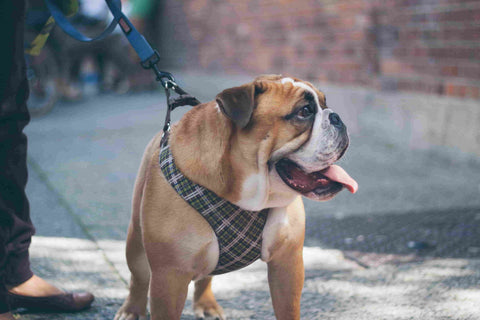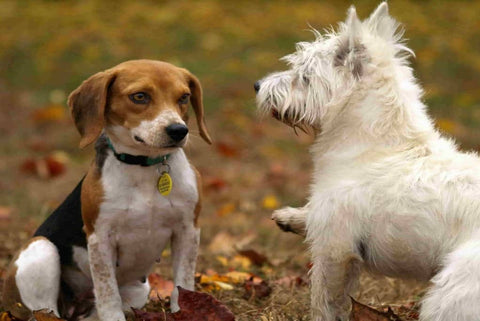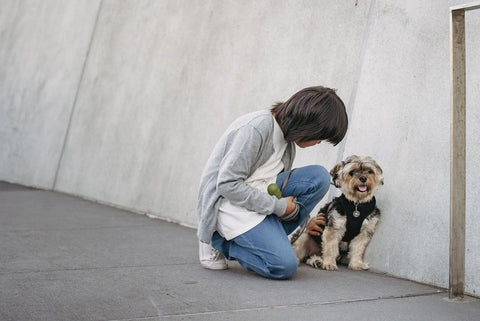Is a Harness Better Than a Collar?
As a pet owner, your priority is safety, comfort, and choosing the gear that’s best for your dog. You want to walk your dog enough so that he’s mentally and physically healthy, but you want to do so knowing that you’re in control and he’s also safe. A harness is better than a traditional collar, and below we provide you with everything you need to know!
Benefits You Can Get from a Harness
The following are some of the primary advantages of using a harness compared to a traditional collar:
1) Safety: When you use a collar, there’s a lot of pressure that’s being applied directly at your dog’s neck. This increases the risk of injury, and there’s also more of a risk of your dog escaping from a collar than a secure harness.
2) Training: Learning how to walk properly is an important area of training for your dog. A harness can be a training tool, especially when you use the front clip attachment for your leash. When your leash is attached to the front clip of a harness, if your dog tries to pull, there’s tension put on the space between his shoulder blades. Eventually, he learns not to repeat this pulling behavior.
3) Comfort: When a dog is wearing a collar, as was mentioned above, there is a lot of pressure and potentially force being applied to his neck and trachea. A harness distributes the pressure evenly across your dog’s body, so it’s more comfortable without sacrificing security or control. Choosing the right size dog harness is also key for comfort.
4) Functionality: There’s the versatility that comes with using a dog harness compared to a collar. You can use it for training, but also for leisurely walks. You can get the most functionality when you opt for a dual-clip harness, with a leash attachment at both the front and back. Inherent in the design of a dual-clip harness are features to discourage pulling and help train your dog more efficiently and effectively.
5) Teamwork: Training your dog to walk properly helps the two of you become a team. When your dog is well-trained, you can anticipate what he’s going to do, giving you peace of mind. Also, there will be a point when your dog knows what to expect when you pick up his harness. He’ll be ready to go for a walk.
6) No tightening: Choosing a well-fitting harness is critical for comfort and functionality, but once you do that, you don’t have to constantly adjust it. Dogs tend to prefer wearing a harness over a collar, too, because they are so much more comfortable for them.
Reasons for Choosing a Collar
With so many advantages of a harness, why do people still opt for the collar? There are a few upsides, although they’re overshadowed by the benefits of harnesses.
1) Bulk/Weight: Collars are smaller are lighter weight, so they might be easier to transport and travel with.
2) Simplicity/Ease of Use: Some people find it’s easier to put a collar on their dog than a harness. Once you get the hang of it, though, you can put a harness on just as quickly.
3) Designs: Another reason you might choose a collar instead of a harness is because you prefer the design options. We love designing products that look great and are also functional, however, so if you want design options, we encourage you to check out our Pet&Cuddle harnesses.
How to Choose the Right Size of a Dog Harness?
While knowing your dog’s weight can help you get started to choose the right size harness, it’s not the only factor that matters. We always tell our customers to get their dog’s measurements before they order a harness. When it fits well, it’s going to increase the comfort, safety, and functionality. Then, once you have the measurements, compare them to our size charts.
Measure Your Dog
Use a tape measure and follow the steps below to fit your dog for a harness
- Step One: Measure your dog’s neck girth. This is a measurement of the widest part of your dog’s neck, at the base. Think about where a collar would sit typically, and measure the circumference here with your tape measure.
- Step Two: Find a point that’s around an inch in front of your dog’s back legs. Wrap your tape measure around this point for belly girth.
- Step Three: Measure your dog’s chest girth, which the widest part of his chest right behind his front legs. If your dog has a deeper chest, this measurement is especially important.
- Step Four: To find out your dog’s body length, begin right behind the front leg. Bring your tape measure to the point located directly behind his rear leg.
- Step Five: When you’ve gathered your measurements, then you should compare them to our Pet&Cuddle size chart and choose the appropriate size.
- Note: If your dog is between sizes or seems to be on the cutoff of a size limit, go up in size when you choose the harness. Also, if your dog has very thick fur and measurements fall between a size, make sure you size up.
Select the Dog Harness by Weight and Breed
While we think having the exact measurements is most important for sizing a dog harness, you can also use your dog’s weight and breed to give you a general idea of the correct size. Regardless of your dog’s breed, though, make sure you still check measurements. Here’s a list of sizes that are frequently used by particular breeds.
Breeds that Fit a Small Harness
A small dog usually has a chest girth of 17 to 22 inches, with a weight of 18 to 35 pounds. Breeds that tend to use small harnesses are:
- Cavalier King Charles
- Pekingese
- Miniature Schnauzer
- Pug
- Scottish Terrier
Breeds That Fit a Medium Harness
Medium harnesses may fit a dog with a chest girth of 22 to 27 inches and a weight of 30 to 50 pounds. Medium dog breeds include:
- Beagle
- Border collie
- Boston Terrier
- English Bulldog
- French Bulldog
Breeds That Fit a Large Harness
For a dog with a chest girth of 27 to 32 inches and a weight over 45 pounds, a large harness may fit well. Large breeds include:
- Boxer
- Dalmatian
- Golden Retriever
- Labrador Retriever
- Weimaraner
For more information, check out the full list of breeds here.
Features to Consider While Choosing a Dog Harness
When you’re comparing dog harnesses, there are a lot of available options. How do you know which one is best? Below are some must-have features that you should look for.
- Ease of Use: You want a design that’s well-made and high-quality but at the same time simple for you to use, including putting it on and taking it off.
- Safe Design: Our designs at Pet&Cuddle prioritize safety. Harnesses are inherently safer than collars, so they reduce the risk of choking or injuring your dog’s neck.
- Weight: Look for a lightweight design that you can easily throw in your bag and take with you anywhere.
- Clip Location: We prefer a dual-clip harness, meaning there’s a leash attachment clip at your dog’s front and back. This gives you more versatility in how you use it.
- Adjustable Belts: Even when you get your dog’s measurements before ordering a harness, you still want it to be adjustable, so it’s a comfortable, customized fit.
- Reflective Straps: Choose a harness with reflective elements, especially if you like walking in the early morning or evening.
- Material: Choose soft, non-irritating materials that feel good for your dog to encourage him to wear his new harness.
How to Adapt Your Dog to a Harness
If your dog isn’t used to wearing a harness, it can a little adjustment, which is normal. Take it slowly and follow a few steps to acclimate your dog to wearing a harness.
- First: Introduce your dog to the harness without putting it on him. Let him play with it, sniff it and generally interact with it so that he can get used to it. Don’t jump right into having him wear it if your dog isn’t used to a harness.
- Next: Take it with you. If you go for a walk and your dog typically wears a collar, just carry the harness along with you for the time being. Then your dog will start to associate it with walks.
- Then: Have your dog wear the harness around the house for short periods of time.
- Finally: Be patient and give your dog time. Eventually, he’ll be ready to go for his first walk with a harness.
Is It Okay to Use a Retractable Leash for a Dog Harness?
A retractable leash is one of our favorite pieces of gear. With this type of leash, you can give your dog more freedom to explore when that’s an option, but you can also keep him close in more crowded or congested areas.
Some people worry a retractable leash isn’t safe to use with a harness, but it is. You do always need to be mindful of what your dog’s doing and what your surroundings are when using a retractable leash. You should also use the top clip of your harness if possible when you’re using a retractable leash.
If you’re using the front clip of a harness paired with a retractable leash, keep slack in the leash line. This will help avoid confusion for your dog, who might otherwise think they’re pulling even when they’re not.
Should You Really Use a Harness?
When you get a harness that’s well-made and fits properly, you’ll be able to use it safely. If you’ve already decided a harness is right for both you and your dog, take some measurements and browse our selection. Our experts can help you along the way as well.
We, the Pet&Cuddle dog lovers, are constantly creating new dog harness collections, which are safe, multifunctional, and effective for training, leading, or adapting purposes.
Check out the latest dog harness collection we created exactly for your dog here.
Questions About Using Dog Harnesses
We have experience working with many customers and learning more about what’s important to them when choosing pet gear and also the questions they frequently have. To help you from our experience, we put together some of the questions we hear most commonly about dog harnesses.
Can a Dog Wear a Collar and a Harness?
If your dog is wearing a harness, there’s no need to also wear a collar. We recommend against it because collars aren’t as safe as harnesses. A harness can do everything that a collar can, be more safely and comfortably.
Can Dogs Wear a Harness 24/7?
A harness should not be worn all the time. You should remove it when you return home from a walk. It can cause injuries, problems with blood circulation, skin irritation, and other health issues if your dog wears it all the time. Instead, your dog should know that when the harness comes out, it’s time for a walk.
Should I Use a Harness with a Puppy?
You can safely use a harness with a puppy, with a few things in mind. First, most vets recommend your puppy is at least eight months old to start using a harness. You can talk to your vet and get their opinion. The second consideration is choosing the right size. Make sure you don’t get a harness that’s too big for a puppy because that can increase the risk of escape or injury.
How to Fit a Dog Harness Properly?
A harness needs to fit your dog snugly, but it shouldn’t be too tight. You should be able to slip two fingers under any point on the harness. Otherwise, it’s too small. At the same time, if a harness is too loose it can also pose a risk. Make sure that you can’t slip it over your dog’s head, in which case, it’s too big. The best way to get the perfect fit is to measure your dog and to get a harness with adjustable straps.
What Is the Best Dog Harness?
The best harness is one that fits well and is comfortable, as well as being made for longevity. Those are the most important things to remember when you’re shopping for a dog harness.
Get the Best Harness from Pet&Cuddle
We, at Pet&Cuddle, have processed all the knowledge and practical experiences to create the perfect harness with a unique design. Comfortable and safe, it now can be easily used for many purposes like training, walking, or adapting to a leash.
Discover the latest products for dogs available on our website!




